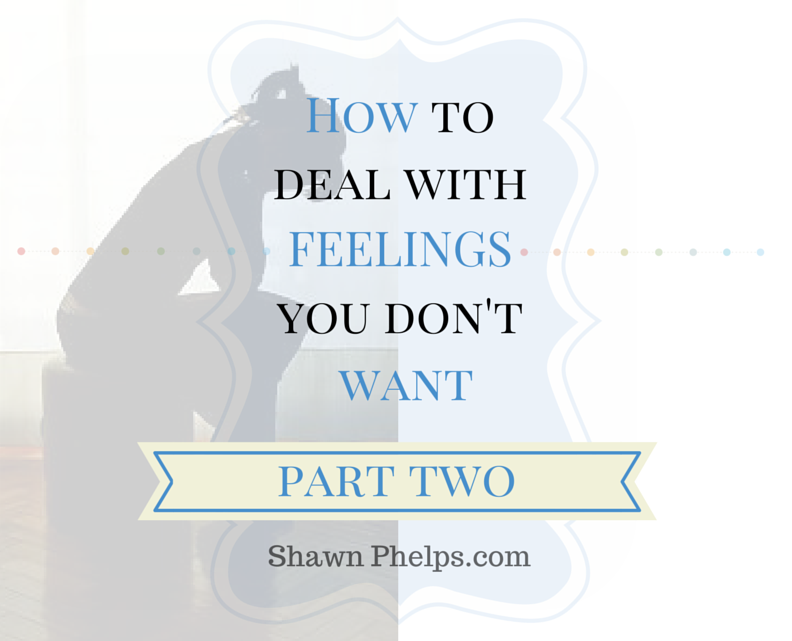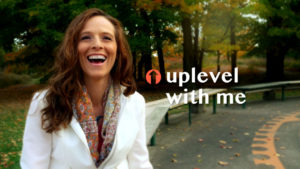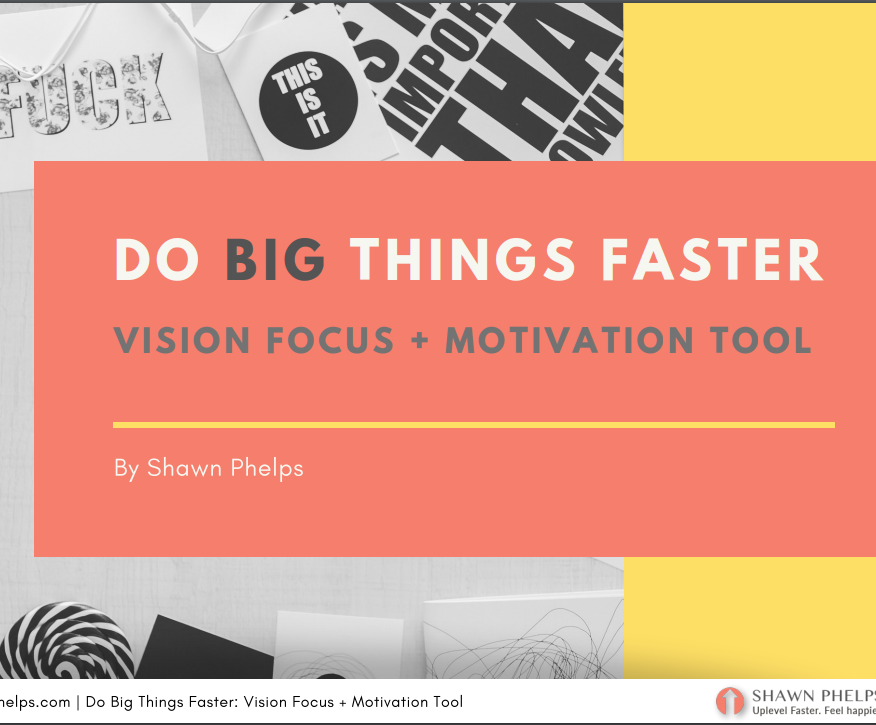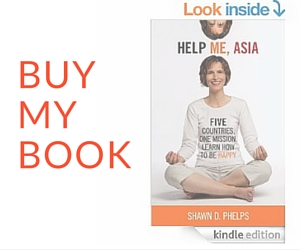Quick. You’re feeling feelings you don’t want to feel. What do you do?
As I explained in Part 1 of this post, if you’re like most people, you run to your favourite vice—coffee, sweets, ciggys, your phone (or, maybe you grab your list of positive affirmations and dance around your house to shift your energy). But none of this solves the root of your problem.
To solve the problem once and for all, you have to actually feel and process these emotions. I’ll explain how and why further down in this post. First, you’re going to need to do a little detective work on yourself.
What’s Your Go-To Emotion?
We all have patterns of emotion that were developed during our childhood formative years. Maybe you’re quick to become annoyed, angry, bored or sad. For each of us there is usually one or two predominant emotions. For me it was sadness with an undercurrent of anger—which makes sense if you’ve read about my childhood in previous posts.
Most people are not aware of what their predominant emotions are, because they’ve spent much of their lives avoiding feeling them. So, to become aware of these patterns you will have to make an effort.
Pause here for a moment…and think about what your go-to emotions might be.
What Are Your Go-To Defence Mechanisms?
For every emotion we don’t want to feel, we develop defence mechanisms to avoid it.
Defence mechanisms provide relief from your symptoms (emotions) but they actually maintain and strengthen the underlying problem. This is why people who don’t develop awareness of their own emotions and related issues generally become more neurotic and “set in their ways” as they age. Each time we use a defence mechanism it draws a line in the sand. Eventually these lines run so deep in our psyche that shifting them becomes nearly impossible.
Defence mechanisms make up the core of your False Self, and they exist because they were needed during your childhood to protect your mind/self from anxiety, guilt, embarrassment, shame and other unwanted feelings, and also to give you a refuge from any situations you weren’t equipped to cope with. These strategies, which are employed by your subconscious, work by manipulating, denying or distorting reality so you don’t have to deal with emotions or impulses you don’t like.
In my work, I recognize two different levels of defence mechanisms.
- 1. Moment by moment defence mechanisms. When an uncomfortable emotion surfaces, most people use denial/distraction (our phones, our work, music, drama, food, booze, etc.), but for those with deeply abusive childhoods, there will be many more.
- 2. Life structure defence mechanisms. This is how you’ve structured your life so you can avoid feeling these emotions. For example, I interviewed a radio host who chose this career because he never had time to think or feel while he did it; he was forced to stay in the moment (however, as soon as he went home, the anxiety and depression was there, waiting for him). He really wanted to be a writer, but he couldn’t stand to be alone with himself long enough to make this dream come true. Perennial “helpers” often fall into this category as well—they pour all their energy into helping others because it’s a “noble” way to avoid processing their own emotions (and people keep telling them how wonderful they are, which is a bonus). Of course there are many people who just enjoy helping people. The difference is that one is truly happy and the other is using it as a way to repress/avoid their own pain.
Pause here for a moment…and think about what your go-to defence mechanisms might be.
Emotional Awareness: The Practice
It all begins with awareness. You can’t heal what you don’t want to acknowledge.
To process (heal) old emotional pain we need to play the game of detective into our own experience. What we’re going to do is use one part of our brain (the neocortex, responsible for consciousness and language) to observe the other, older part (the amygdala) of the brain.
Because one part of you is observing another, this works best if you imagine that you are a book author observing a character in a novel—the character that is “you”. This depersonalizes the experience, so you can be more objective.
- Acknowledge the feeling. It’s there and it’s not going away, no matter how many cookies you eat. You might as well stop ignoring it and/or trying to beat it into submission and just say hello.
- Observe the feeling. Sit still and close your eyes. Locate where you feel the discomfort of these unwanted emotions in your body. Usually it will be in your throat, chest, solar plexus and stomach areas. There may also be a sensation of adrenalin rushing through your whole body. Scan your body from top to bottom and note all the places where you feel something you don’t want to feel. (Also, be aware of how strong the urge is to go and do something else—notice the thoughts that pop up telling you about all the other things you could/should be doing; that’s your subconscious defence mechanisms in action.)
- What does it feel like? Be a detective. Examine it closely. Is it tight, burning, heavy, pulsing or? Is it subtle or intense? One of the fascinating things about emotions is that they manifest as physical sensations. As someone who has practiced meditation daily for over 13 years, I’ve spent thousands of hours observing the physical sensations of unwanted emotions. One thing I’ve learned is you definitely do “feel” emotional pain just as much as you “feel” physical pain—and it can be just as stubborn. Emotional pain is experienced as an uncomfortable energy (some just call it “an icky feeling”).
- What thoughts are connected with this feeling? Don’t get lost in them, but take a few minutes to notice them. Remember you are observing these thoughts right now as though they belong to someone else (a character in a novel), not getting caught up in what’s playing out as you would if they belonged to “you”.
- Breathe. Really, just breathe. Stay present with the feeling and take three long, deep breaths. Don’t try to fix, change or analyze the feelings or visualize “happy things”. Allow space for the feelings to be there and take a few deep breaths into them. If you have the courage, stay with them for three more breaths and so on, until you really feel like you can’t stay with it any longer. After that, feel free to indulge your usual defence mechanisms!
If you do this on a daily basis (a few times per day) not only will you develop a high level of emotional awareness (essential for authentic relationships and stepping into the power of your True Self), but you will also be slowly processing those old feelings once and for all, making you feel lighter and happier.
Why This Works
When you use the neo-cortex part of your brain to observe the amygdala part of your brain without judgment (that’s key), it actually changes the formative emotional patterns that were created during your childhood. That’s what mindfulness meditation does, and why hospitals are all using it now to treat anxiety, depression and more. What I’m teaching you is a very emotion-focused version of mindfulness, that I found gave me the best results for processing old emotions over time. (Though I eventually graduated to observing my breath and emotions for hours at a time, in the same way a person may watch a soccer match, without needing to take deep breaths to calm my nervous system.)
Along with observing the amygdala, you are observing the hypothalamus, which activates your sympathetic nervous system. This part is responsible for setting off your neuronal and hormonal stress response (a.k.a. the fight-or-flight response, which leads to those uncomfortable feelings). By just observing without creating any new emotional waves with judgment etc., the parasympathetic nervous system is activated (the rest and digest part), which turns off the emotional “alarms”.
By observing this part of yourself without judgment, it has a similar effect as the deer shaking off its emotional trauma when it was hit by a car (as explained in my last post); it breaks the mind-body connection. Or, if we use the Dr. Jekyll vs. Mr. Hyde example (also from my last post), when Dr. Jekyll stops judging, denying and repressing Mr. Hyde, the two become integrated into one.
This is the predominant practice I have used to heal my own life-long patterns of severe anxiety (PTSD-based), depression and disassociation (I lacked any core feeling of “self”), and also to clear away a long list of complex defence mechanisms. I still have a few left, but I’m aware of them when they show up, and can usually head them off before they get me into trouble. “Usually” being the operative word. Hey, I’m human!
The rewards have been great—I live with a man who loves me unconditionally for the authentic me, and we both support each other as we grow toward our full potential. My family and I have developed a deep understanding of each others’ patterns, so our relationships are better than ever before. I’m surrounded by true friends, totally genuine and authentic, and fearless when it comes to talking openly with me about their feelings and mine. All of this has been like winning the lottery.
Add to that, how it has opened doors of opportunity in my career that I never imagined. When you integrate those emotional experiences you become much more present and powerful, to the point where people can feel it. It’s the primary reason why I can do the intuitive/clairvoyant work that I do with people.
A Helpful Book!
If you’re excited to try this practice out, this book will make it quick and easy to understand your own emotional patterns (I wish I found it a decade before I did). It comes with descriptions of our emotions, the unique ways we avoid them and strategies to help us integrate them. Though I’m not much into chakra-stuff, I found the emotion-based chakra charts useful, because they helped me understand why I felt sensations predominantly in my throat and chest or wherever, plus there are clear diagrams of how all these patterns play out. The Heart of the Soul: Emotional Awareness, by Gary Zukav and Linda Francis.
In Closing
I could go on and on about the benefits of this, but let’s leave it at: I really believe this is one of the most powerful practices for transforming your life. I would not be where I am now without it. No, it’s not fast, but the results begin as soon as you start practicing, and they grow like gangbusters over time.
In my next few posts, I’m going to teach you a few other practices I’ve used with great results. I’m grateful for this opportunity to share all the things I’ve learned with you that have made my life so much better than I imagined it could be.




